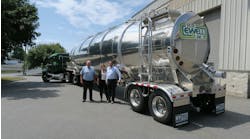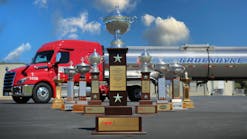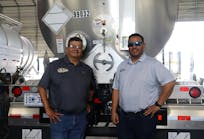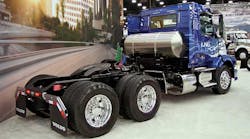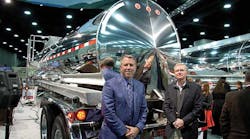Latest from Features
Volvo’s 2014 GHG-certified engines exceeding fuel efficiency expectations
VOLVO Trucks’ Greenhouse Gas (GHG) 2014-certified engines are providing even greater fuel efficiency than anticipated, Volvo Trucks officials announced during the 2014 Mid-America Trucking Show in Louisville, Kentucky. The integrated engines are delivering up to a 3% fuel efficiency improvement compared with their 2013 counterparts.
“We remain focused on ensuring that the ongoing phases of engine and vehicle regulations do not burden our customers, but instead create value for their operations,” said Göran Nyberg, president, Volvo Trucks North American Sales & Marketing. “Introduction of our SCR-equipped models yielded a 5% fuel efficiency increase, and we’re pleased to announce that our 2014 engine lineup is delivering up to an additional 3% savings.”
Volvo officials also said the truck builder continues to make progress with its alternative fuel portfolio. The company is making good progress with development of an engine that runs on dimethyl ether, and test vehicles continue to perform well. In addition, the company is moving forward with its natural gas engine development efforts.
On the diesel engine side, a combination of in-lab and on-road testing proved that the initially announced fuel efficiency figures of up to 2% understated the true fuel savings and value of 2014 Volvo engines.
“Fuel efficiency remains top-of-mind across the industry, but there’s no one-size-fits-all solution that will deliver massive improvements. Every drop counts,” Nyberg said. “On average, a 1% fuel efficiency improvement amounts to annual savings of more than $650 per truck. Carriers ignoring opportunities for incremental fuel efficiency gains are leaving money on the table.”
Refinements and design changes contributing to fuel efficiency improvements in Volvo’s 2014 D11, D13, and D16 engines include:
• Low-friction cylinder improvements, including a redesigned piston, liner and oil scraper ring developed with smoother surfaces;
• A clutched air compressor, which reduces engine load by completely disengaging the clutch from the engine when not in use;
• Advanced combustion technology of a new seven-hole injector, which offers better fuel atomization for a more even distribution of fuel within the cylinder, maximizing fuel efficiency and offering a greater savings for customers; and
• An improved crankcase ventilation system, which filters more oil from blowby gases before they leave the engine and at the same time improves engine backpressure for better performance.
Along with fuel efficiency improvements, a two-piece valve cover on the D13 engine improves serviceability, which helps reduce repair time and is easier to handle than previous covers. Volvo also removed lead from the valvetrain of its 2014 engines to reduce its environmental impact.
In addition to the fuel efficiency gains delivered with 2014 Volvo engine technology, Volvo Trucks’ XE—exceptional efficiency—powertrain package boosts fuel efficiency by up to an additional 3%. Available on Volvo VNM and VNL models equipped with 2014 Volvo engines, the XE11, XE13, and XE16 packages improve fuel efficiency by lowering engine rpm at a given vehicle speed, a concept Volvo calls “downspeeding.” Possible through the combination of Volvo’s standard I-Shift automated manual transmission and Volvo engine with modified software, XE allows the engine to cruise about 200 rpm less than the average truck sold today.
Fuel efficiency improves by about 1.5% for every 100 rpm of downspeeding, so customers spec’ing the XE package can expect up to a 3% improvement when compared with another overdrive transmission in a similar operation. Demand for XE powertrain packages has grown each year since the initial introduction of XE13 for the D13 engine.
In 2013, about 87% of all Volvo trucks invoiced in the United Statres and Canada were specified with a Volvo engine. Of that population, 23% featured XE powertrain packages.

